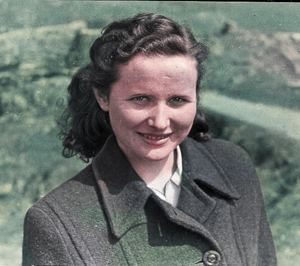Flora MacNeil facts for kids
Quick facts for kids
Flora MacNeil
|
|
|---|---|
 |
|
| Born | 6 October 1928 |
| Died | 15 May 2015 (aged 86) |
Flora MacNeil, MBE (born October 6, 1928 – died May 15, 2015) was a famous Scottish Gaelic singer. She became well-known after meeting Alan Lomax and Hamish Henderson in the early 1950s. Flora kept singing and performing for many years. She was also awarded an MBE for her contributions.
Growing Up in Barra
Flora MacNeil was born in 1928 on the island of Barra in Scotland. Her family spoke Gaelic and were Catholic. They lived on a small farm in Ledag, Castlebay. Barra is sometimes called "the island the Reformation never reached," meaning it kept its traditional ways.
Singing was a big part of Flora's family life. The men often went to sea for long trips. The women stayed home to care for the children and their small farm. They sang a lot while working. Flora's mother, Ann Gillies, was a singer. Her father, Seumas MacNeil, was a fisherman who died when Flora was 14.
Before TV and radio, ceilidhs (gatherings with music and stories) happened often on Barra. From a very young age, Flora learned hundreds of songs just by listening. She learned most of her songs from her mother. Another important source was her mother's cousin, Mary Johnstone. Mary's parents had been forced to leave their home during the Highland Clearances. They moved to other islands before Mary returned to Barra. Mary often sang at local ceilidhs, so Flora also learned many Gaelic songs from those other islands.
Flora's talent for music was clear from a young age. When she was only four, she was already singing complex songs. One famous song she sang was Mo rùn geal òg ("My Fair Young Love"). This was one of the Òrain Mòr, or "Big Songs," which are long and important traditional songs.
Starting Her Music Career
After her father passed away, 14-year-old Flora left school. She started working at the island's telephone exchange to help her family. In 1949, she was offered a job in Edinburgh, so she moved there.
People in Edinburgh had already heard about Flora's amazing singing talent. She was welcomed by poets and folk song promoters like Hugh MacDiarmid, Hamish Henderson, and Sorley MacLean. They helped her find places to perform at ceilidhs and concerts in Edinburgh. This was the start of the British folk revival, a time when traditional music became popular again.
Sorley MacLean and Hamish Henderson also arranged for an American music expert named Alan Lomax to meet Flora. Lomax recorded her singing. He later remembered his first time hearing her in 1951: "It was in Edinburgh one June night in the house of Sorley MacLean, a poet, that Scotland really took hold of me. A blue-eyed girl from the Hebrides was singing." That girl was Flora MacNeil, and the song was Cairistiona.
Hamish Henderson also invited Flora to sing at the 1951 Edinburgh People's Festival Ceilidh. This event brought Scottish traditional music to a large audience for the first time. It took place in Edinburgh's Oddfellows Hall in August 1951. Flora MacNeil, along with other singers from Barra like Calum Johnston, performed there. Alan Lomax recorded the music live.
During the Ceilidh, two Scottish Gaelic songs about the Jacobite rising of 1745 were performed. Calum Johnston sang Òran Eile don Phrionnsa ("Another Song to the Prince"). Flora MacNeil then sang Mo rùn geal òg. This song was a sad farewell for a man named William Chisholm, who died fighting in the Jacobite Army at the Battle of Culloden in 1746.
Later in the Ceilidh, Flora sang a Waulking song called Cò siod thall air stràid na h-eala? ("Who is That Yonder on the Swan Road?"). She also performed the Gaelic sad song, Mo nighean donn bhòidheach ("My Lovely Brown-Haired Girl").
The Edinburgh People's Festival Ceilidhs happened every year until 1954.
In 1975, a folk expert named Peter Kennedy said that Flora MacNeil was the source for 24 Scottish Gaelic songs in his book Folksongs of Britain and Ireland.
Flora MacNeil recorded two albums: Craobh nan Ubhal in 1976 and Orain Floraidh in 2000.
In 2000, while performing at a ceilidh in Cape Breton, Nova Scotia, Flora spread her arms wide and said, "You are my people!" The hundreds of Canadian-born Gaels in the audience cheered loudly.
In 2005, Alan Lomax's recordings from the 1951 Ceilidh were released on compact disc. All of Lomax's recordings have since been put online by the Association for Cultural Equity.
Personal Life
In 1955, Flora MacNeil married Alister MacInnes, who was also from Barra. Alister worked as a lawyer in Glasgow. They raised their five children there: Kenneth, Cairistiona, Seumas, Maggie, and Donald.
Later Years and Legacy
Flora MacNeil passed away on May 15, 2015, at the age of 86, after a short illness.
Many other Gaelic traditional singers, like Karen Matheson and Julie Fowlis, have said that Flora MacNeil was a very important influence on their careers.
Flora's daughter, Maggie MacInnes, also became a Gaelic traditional singer and harpist, carrying on the family's musical tradition.


